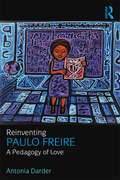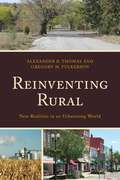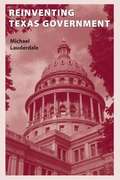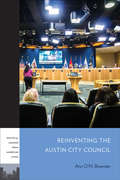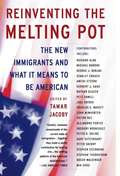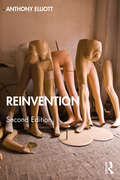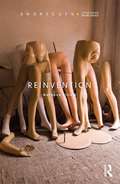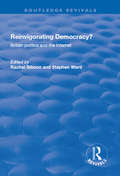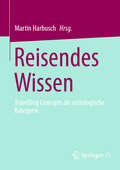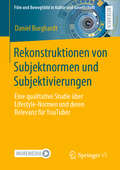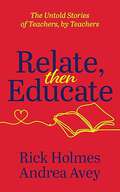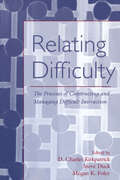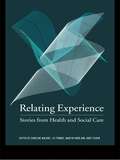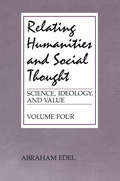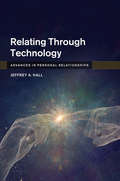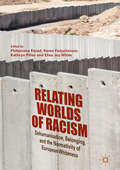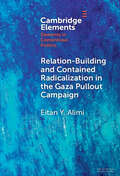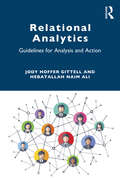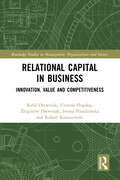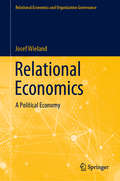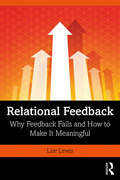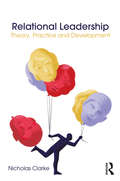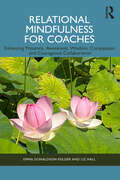- Table View
- List View
Reinventing Paulo Freire
by Antonia DarderOne of the most influential critical educators of the twentieth century, Paulo Freire challenged those educational inequalities and conditions of injustice faced by oppressed populations. In this new edition of Reinventing Paulo Freire, Antonia Darder re-examines his legacy through reflections on Freirean pedagogy and the narratives of teachers who reinvent his work. The fully revised first part provides important historical, political, and economic connections between major societal concerns and educational questions raised by Freire and their link to the contemporary moment, including questions tied to neoliberalism, coloniality, and educational inequalities. At the heart of the book is a critical understanding of how Freire#65533;s pedagogy of love can inform, in theory and practice, a humanizing approach to teaching and learning. Powerful teacher narratives offer examples of a living praxis, committed to democratic classroom life and the emancipation of subaltern communities. The narratives clearly illustrate how Freire#65533;s ideas can be put concretely into practice in schools and communities. These reflections on Freirean praxis are sure to spark conversation and inspiration in teacher education courses. Through a close theoretical engagement of Freire#65533;s ideas and key insights garnered from lived experiences, the book speaks to the ways Freire can still inspire contemporary educators to adopt the spirit of#65533;liberatory pedagogy, By so doing, Reinventing Paulo Freire is certain to advance his theories in new ways, both to those familiar with his work and to those studying Freire for the first time.
Reinventing Practice in a Disenchanted World
by Cheleen Ann-Catherine MaharColonia Hermosa, now considered a suburb of Oaxaca, began as a squatter settlement in the 1950s. The original residents came in search of transformation from migrants to urban citizens, struggling from rural poverty for the chance to be part of the global economy in Oaxaca. Cheleen Ann-Catherine Mahar charts the lives of a group of residents in Colonia Hermosa over a period of thirty years, as Mexico became more closely tied into the structures of global capital, and the residents of Colonia Hermosa struggled to survive. Residents shape their discussions within a larger narrative, and their talk is the language of the heroic individual, so necessary to the ideology and the functioning of capital. However, this logic only tenuously connects to the actual material circumstances of their lives. Mahar applies the theories of French sociologist Pierre Bourdieu to her data from Mexico in order to examine the class trajectories of migrant families over more than three decades. Through this investigation, Mahar adds an important intergenerational study to the existing body of literature on Oaxaca, particularly concerning the factors that have reshaped the lives of urban working poor families and have created a working-class fraction of globalized citizenship.
Reinventing Rural: New Realities in an Urbanizing World (Studies in Urban–Rural Dynamics)
by Alexander Thomas Michael Fortunato Stephanie Bennett Gregory Fulkerson Aimee Vieira Fern Willits Leanne Avery Matthew Clement Carrie Kane Laura McKinney Gene TheodoriReinventing Rural is a collection of original research papers that examine the ways in which rural people and places are changing in the context of an urbanizing world. This includes exploring the role of the environment, the economy, and related issues such as tourism. While traditionally relying on primary sector work in agriculture, mining, natural resources, and the like, rural areas are finding new ways to sustain themselves. This involves a new emphasis on environmental protection, as one important strategy has been to capitalize on natural amenities to attract residents and tourists. Beyond improvements to the economy are general improvements to the quality-of-life in rural communities. Consistent with this, the volume focuses on the two cornerstones of education and health, considering current challenges and offering ideas for reinventing rural quality-of-life.
Reinventing Texas Government
by Michael LauderdaleThe Survey of Organizational Excellence is revolutionizing the operation of Texas state agencies and other governmental and private organizations. Developed and refined over the last twenty years by a team of researchers led by Michael Lauderdale, the survey is a proven tool for improving the effectiveness of state government services through surveys of employee attitudes toward their organizations. In this book, Lauderdale gives a history of the survey and its use under four governors, including George W. Bush. He explains what the survey is, how to use it, and how to apply its results to organizational change and improvement. Step-by-step instructions for planning, implementing, and evaluating the survey are enhanced with real-life case studies from the 140,000 surveys that have been distributed and used by more than 75 different organizations. Lauderdale also sets the survey in a broader perspective by identifying some of the forces currently impelling change in organizations throughout our society and exploring where this push for change is taking us.
Reinventing the Austin City Council (PLAC: Political Lessons from American Cities)
by Ann O'M. BowmanUntil recently, Austin, the progressive, politically liberal capital of Texas, elected its city council using a not-so-progressive system. Candidates competed citywide for seats, and voters could cast ballots for as many candidates as there were seats up for election. However, this approach disadvantages the representation of geographically-concentrated minority groups, thereby—among other things—preventing the benefits of growth from reaching all of the city’s communities. Reinventing the Austin City Council explores the puzzle that was Austin’s reluctance to alter its at-large system and establish a geographically-based, single-member district system. Ann Bowman chronicles the repeated attempts to change the system, the eventual decision to do so, and the consequences of that change. In the process, she explores the many twists and turns that occurred in Austin as it struggled to design a fair system of representation. Reinventing the Austin City Council assesses the impact of the new district system since its inception in 2014. Austin’s experience ultimately offers a political lesson for creating institutional change.
Reinventing the Melting Pot: The New Immigrants and What It Means To Be American
by Tamar JacobyIn Reinventing the Melting Pot, twenty-one of the writers who have thought longest and hardest about immigration come together around a surprising consensus: yes, immigrant absorption still works-and given the number of newcomers arriving today, the nation's future depends on it. But it need not be incompatible with ethnic identity-and we as a nation need to find new ways to talk about and encourage becoming American. In the wake of 9/11 it couldn't be more important to help these newcomers find a way to fit in. Running through these essays is a single common theme: Although ethnicity plays a more important role now than ever before, today's newcomers can and will become Americans and enrich our national life-reinventing the melting pot and reminding us all what we have in common.
Reinvention
by Anthony ElliottOurs is the era of "reinvention". From psychotherapy to life coaching, from self-help manuals to cosmetic surgery and from corporate rebranding to urban redesign: the art of reinvention is inextricably interwoven with the lure of the next frontier, the breakthrough to the next boundary – especially boundaries of the self. In this new, updated edition of this remarkable book, Anthony Elliott examines "reinvention" as a key buzzword of our times. Through a wide-ranging and impassioned assessment, Elliott unmasks the ever-increasing globalization of reinvention – from reinvention gurus to business reinvention, from personal makeovers to corporate rebrandings. In doing so, he undertakes a serious if often amusing consideration of contemporary reinvention practices, including super-fast weight-loss diets, celebrity makeovers, body augmentations, speed dating, online relationship therapies, organizational restructurings, business downsizings and many more. The second edition of Reinvention includes a new chapter on the digital revolution and artificial intelligence, which situates reinvention within the context of technological automation. There is also a discussion of how the Covid-19 global pandemic has impacted today’s cultures of reinvention. In addition, there is a new concluding chapter in which the author develops further his theoretical account of the nature of reinvention societies. This absorbing book will continue to be the ideal introduction to reinvention for students and general readers alike. Reinvention offers a provocative and radical reflection on an issue (sometimes treated as trivial in the public sphere) that is increasingly politically urgent in terms of its personal, social and environmental consequences.
Reinvention (Shortcuts)
by Anthony ElliottOurs is the era of ‘reinvention’. From psychotherapy to life coaching, from self-help manuals to cosmetic surgery, and from corporate rebranding to urban redesign: the art of reinvention is inextricably interwoven with the lure of the next frontier, the breakthrough to the next boundary – especially boundaries of the self. In this insightful and provocative book, Anthony Elliott examines ‘reinvention’ as a key buzzword of our times. Through a wide-ranging and impassioned assessment, Elliott reviews the new global forms of reinvention – from reinvention gurus to business reinvention, from personal makeovers to corporate rebrandings. In doing so, he undertakes a serious if often amusing consideration of contemporary reinvention practices, including super-fast weight loss diets, celebrity makeovers, body augmentations, speed dating, online relationship therapies, organizational restructurings, business downsizings, and many more. This absorbing book is an ideal introduction to the topic of reinvention for students and general readers alike. Reinvention offers a provocative and radical reflection on an issue (sometimes treated as trivial in the public sphere) that is increasingly politically urgent in terms of its personal, social and environmental consequences.
Reinvigorating Democracy?: British Politics and the Internet
by Stephen Ward Rachel K. GibsonThis title was first published in 2000. This volume examines the extent to which digital technology, such as the World Wide Web, e-mail and developing database software, are being used within the political institutions and organization. The focus is on the UK political system with some reference to the US. The chapters cover central themes surrounding British politics and the use of the Internet and other emerging technologies. Topics include an overview of the development and use of the Internet and its influence, the impact on central and local government, promoting better democratic citizenship, the use of information communication technologies by political parties, the implications of Internet and e-mail use by pressure groups to aid campaigning, and many more.
Reisendes Wissen: Travelling Concepts als soziologische Kategorie
by Martin Harbusch"Viel zu wenig wird untersucht, wer weshalb mit welchen Medien Wissen auf Reisen schickt oder von Reisen mitbringt und wer auf welche Weise sich fremdes Wissen eigensinnig angeeignet, um das Eigene neu zu interpretieren. Der vorliegende Band ist ein gelungener Versuch, die Wege und Praktiken zu beleuchten, mit denen Menschen dies tun." Jo Reichertz
Rekonstruktionen von Subjektnormen und Subjektivierungen: Eine qualitative Studie über Lifestyle-Normen und deren Relevanz für YouTuber (Film und Bewegtbild in Kultur und Gesellschaft)
by Daniel BurghardtAnhand detaillierter Analysen von YouTube-Videos verdeutlicht das Buch, welch zentrale Rolle Subjektnormen für verschiedene Produzent_innen von Lifestyle-Videos spielen. Hierbei werden sowohl unterschiedliche Normen sichtbar, als auch deren Relationen zum Habitus der Untersuchten, welche sich in Aneignungs-, Passungs- und Spannungsverhältnissen sowie in Widersetzungen ausdrücken. Im Kontext der Subjektivierungsforschung und deren Bezugnahme auf Althusser und Foucault lassen sich jene Ausrichtungen als Subjektivierungen deuten, die mal mehr, mal weniger reflektiert vollzogen werden.
Rekonstruktive Paar- und Familienforschung (Studientexte zur Soziologie)
by Dorett FunckeDer Band führt anhand verschiedener Studien in eine Paar- und Familienforschung ein, in der über einen rekonstruktionslogischen Zugang Themenbereiche bearbeitet werden, die diese beiden zentralen Sozialisationsinstanzen betreffen.
Relate, Then Educate: The Untold Stories of Teachers, By Teachers
by Andrea AveyCompiled by two former educators, Relate, Then Educate contains the firsthand stories of sixteen seasoned educators’ professional hurdles and personal moments of heartbreak and joy.To be an educator is to be thrown into the classroom without much practical training. Young teachers can languish for years without knowing if they’re “doing it right,” and, despite the wealth of tactical curriculum resources available, the intangible needs of educators often go overlooked and unmet. Former educators Rick Holmes and Andrea Avey understand this perspective well; they collected the stories within Relate, Then Educate for teachers seeking experienced insight and support as they decide the trajectory of their career. This unbiased collection of candid and approachable experiences are written to challenge, inspire, correct, and console teachers—and humans—who need direction. It features stories of unthinkable tragedy, like the tragic death of a student midyear, and rich rewards, like lifelong friendships with students. Relate, Then Educate breaks down each teacher’s story into three segments: their path into education, a defining moment in their career, and an instructional best practice.
Relating Difficulty: The Processes of Constructing and Managing Difficult Interaction (LEA's Series on Personal Relationships)
by Steve Duck D. Charles Kirkpatrick Megan K. FoleyRelating Difficulty offers insight into the nature of difficulty in relationships across a broad range of human experience. Whether dealing with in-laws or ex-spouses, long-distance relationships or power and status in the workplace, difficulty is an all too common feature of daily life. Relating Difficulty brings the academic understanding of relational processes to the everyday problems people face at home and at work. These essays represent a groundbreaking collection of the multidisciplinary conceptual and empirical work that currently exists on the topic. Along with issues such as chronic illness and money problems, contributors investigate contexts of relational difficulty ranging from everyday gossip, the workplace and shyness to more dangerous sexual “hookups” and partner abuse. Drawing on evidence presented in the volume, editors D. Charles Kirkpatrick, Steve Duck, and Megan K. Foley explain how relational problems do not emerge solely from individuals or even from the relationship itself. Instead, they arise from triangles of connection and negotiation between relational partners, contexts, and outsiders. The volume challenges the simple notion that relating difficulty is just about problems with "difficult people" and offers some genuinely novel insights into a familiar everyday experience. This exceptional volume is essential reading for practitioners, researchers and students of relationships across a wide range of disciplines as well as anyone wanting greater understanding of relational functioning in everyday life and at work.
Relating Experience: Stories from Health and Social Care
by Janet Seden Martin Robb Caroline Malone Liz Forbat<p>This reader provides a diverse selection of accounts of interpersonal communication and relationships in the context of health and social care. Most of the contributions are personal narratives by people using or working in care services; the majority are contemporary and many have been written especially for this anthology. <p>The book also includes other kinds of accounts, including attempts to encapsulate in fictional, poetic and visual form something of the nature of encounters in the context of care. There are sections on changing relationships, the way things happen, the physical context of care, difficult encounters, and working together, as well as cross-cutting themes such as power and diversity. <p>Relating Experience is an essential resource for students of social work, nursing, health and social policy, and for all involved in health and social care services, whether as professionals, carers or service users.</p>
Relating Humanities and Social Thought (Science, Ideology And Values Ser. #Vol. Iv)
by Abraham EdelIn the current atmosphere of controversy about modes of interpreting literature, historical influences in science, and subtle ideologies in social theory, Abraham Edel confronts the institutionalized separation of the humanities and the sciences, the segregation of disciplines through structures that rest on entrenched dualisms, and the isolations reenforced by habits of the academy and its struggles over turf. Edel's "search for connections" - carried out not only theoretically but through a series of particular studies spanning major disciplines from philosophy and social theory to jurisprudence, biography, and cultural anthropology - leads into uncharted waters. He faces the startling conclusion that the clue to answering internal questions characteristically turns out to come from trans-discipline relations.This fourth volume of Edel's Science, Ideology and Value focuses in a Deweyan vein on the functional requirements at the base of the social sciences and humanities alike: discipline structures are subject to change, development, and decay, and even to categorial shifts as well as to readjustments. At the same time, Edel's philosophical nauralism helps diagnose the obstacles to research that stem from imposed dualisms such as theory and practice, subjectivity and objectivity, fact and value, individual and society, as well as social contrasts of elite and mass. Normative structures are to be held responsible to inquiry, and a self-conscious exploratory practice is needed to minimize the risks of arbitrary closures. For those who wish to get beyond sloganeering in the world of education, humane learning, and the social and historical sciences, this book is a must.
Relating Through Technology: Everyday Social Interaction (Advances in Personal Relationships)
by Jeffrey A. HallThis book answers one of the most critical questions of our time, does the vast connectivity afforded by mobile and social media lead to more personal connection with one another? It offers an evidence-based account of the role of technology in close relationships that confronts such pressing questions as where face-to-face communication belongs in this digital age, whether social media is harmful to our well-being, and how online communication spills-over into our offline communication and relationships. Each chapter explores the positive and negative influences of media on relationships, coalescing into a balanced assessment of how technological advancement has altered our connections with each other. By zeroing in on communication with the most important people in our lives and tracing the changes in computer-mediated communication over time, Relating Through Technology focuses the conversation about media on its use in our everyday lives and relationships.
Relating Worlds of Racism: Dehumanisation, Belonging, And The Normativity Of European Whiteness
by Elisa Joy White Philomena Essed Karen Farquharson Kathryn PillayThis international edited collection examines how racism trajectories and manifestations in different locations relate and influence each other. The book unmasks and foregrounds the ways in which notions of European Whiteness have found form in a variety of global contexts that continue to sustain racism as an operational norm resulting in exclusion, violence, human rights violations, isolation and limited full citizenship for individuals who are not racialised as White. The chapters in this book specifically implicate European Whiteness – whether attempting to reflect, negate, or obtain it – in social structures that facilitate and normalise racism. The authors interrogate the dehumanisation of Blackness, arguing that dehumanisation enables the continuation of racism in White dominated societies. As such, the book explores instances of dehumanisation across different contexts, highlighting that although the forms may be locally specific, the outcomes are continually negative for those racialised as Black. The volume is refreshingly extensive in its analyses of racism beyond Europe and the United States, including contributions from Africa, South America and Australia, and illuminates previously unexplored manifestations of racism across the globe.
Relation-Building and Contained Radicalization in the Gaza Pullout Campaign (Elements in Contentious Politics)
by Eitan Y. AlimiThis Element explores the Jewish Settlement Movement's campaign against the Gaza Pullout as a case of contained radicalization. Despite the presence of militant worldviews and propensities for aggression, as factors identified in the literature as drivers of political violence, the campaign saw little violence. The Element offers a detailed analysis of the history of relation-building within the movement and between it and the Israeli State and its agents to explain the ability of leaders from the various contending parties to contain radicalization. It traces the emergence and evolution of central relational mechanisms operating within and between the contending parties over time and during past campaigns. By demonstrating the effects of these mechanisms during the campaign against the Gaza Pullout, the Element shows how the mutually reinforcing relational dynamics mitigated the salience of aggressive propensities and violence-prone ideologies, consequently putting a brake on radicalization.
Relational Analytics: Guidelines for Analysis and Action
by Jody Hoffer Gittell Hebatallah Naim AliThis guidebook goes beyond people analytics to provide a research-based, practice-tested methodology for doing relational analytics, based on the science of relational coordination. We are witnessing a revolution in people analytics, where data are used to identify and leverage human talent to drive performance outcomes. Today’s workplace is interdependent, however, and individuals drive performance through networks that span department, organization and sector boundaries. This book shares the relational coordination framework, with a validated scalable analytic tool that has been used successfully across dozens of countries and industries to understand, measure and influence networks of relationships in and across organizations, and which can be applied at any level in the private and public sectors worldwide. Graduate students and practitioners in human resource management, health policy and management, organizational behavior, engineering and network analysis will appreciate the methodology and hands-on guidance this book provides, with its focus on identifying, analyzing and building networks of productive interdependence. Online resources include data appendices and statistical commands that can be used to conduct all these analyses in readers’ own organizations.
Relational Capital in Business: Innovation, Value and Competitiveness (Routledge Studies in Management, Organizations and Society)
by Rafał Drewniak Urszula Słupska Zbigniew Drewniak Iwona Posadzińska Robert KaraszewskiThe concept of relational capital mainly refers to the value of the relationships a company creates with its stakeholders. These relationships inspired the authors to analyze their importance in the context of creating value for the enterprise and to explore the importance of leadership and communication in building relationships with the environment. Internal relational capital refers to the organization’s set of intellectual property, work processes and methods, executive procedures, databases, communication and information infrastructure. Employee relations and leadership activities become pivotal in this context, as improving relational competence and intra-organizational relational capital can foster building lasting relationships with external stakeholders. This book comprises two parts. The first is devoted to discussing the most important concepts and issues related to the essence and importance of relational capital in modern companies, characterizing methods and tools for building relational capital, while pointing to the role of leadership in shaping employee engagement and building intra-organizational relationships. The second part contains the results of empirical research on the importance of relational capital in organizations from the point of view of managers, and the features and scope of maintained relationships with stakeholders. This research allowed for the evaluation of ongoing relationships in terms of how they improved innovation, financial performance, or access to resources. The book will be especially valuable to researchers, academics, professionals and advanced students in the fields of organizational studies, employment relations and leadership.
Relational Economics: A Political Economy (Relational Economics and Organization Governance)
by Josef WielandThis book introduces the research agenda of relational economics as a political economy for the governance of local and global economic transactions in modern societies. It analyses the mechanisms of global value creation and production networks by studying cooperation in intra- and inter-firm networks, intersectoral stakeholder management, and transcultural leadership. The author develops a categorical taxonomy for private and public value creation based on the effective and efficient interlinking of, and interaction between, a range of resources and abilities. In contrast to mainstream economics, which largely focuses on the laws of discrete and dyadic exchange transactions, this book assesses the polyvalent characteristics of relational transactions. The chief categories involved in an economic theory of the relations between events are the relational transactions and their various forms of governance; the polycontextual cooperation between economic, political and civil society agents; and the factor incomes and relational rents that relational transactions produce. Today, relational transactions are the rule, not the exception, in modern economies and their global value creation networks. Given its scope and focus, this book will appeal to scholars of economics, economic sociology, organisational studies and related fields.
Relational Feedback: Why Feedback Fails and How to Make It Meaningful
by Lise LewisPeople are increasingly disenchanted with performance improvement techniques that fail to deliver. This book offers a new and refreshing way of engaging in authentic feedback that is willingly given and well-received. It demonstrates that focusing on the quality of relationship improves the activity of feedback. The Relational Leadership WAY© that is the core of this book was created from a thematic analysis of a doctoral research study. The framework encourages effective relationships and works through perfecting a ‘way of being’ that is generative and productive in interactions with others; especially in feedback conversations, whether we are the giver or the receiver. The 10 themes integral to the framework are organised into 3 parts that relate to pivotal points in a conversation and that when given focused attention will improve relationships: What needs preparing to establish relationships that stimulate constructive conversations Active engagement in co-creating generative conversations through adopting relational behaviours You both noticing and reacting to what emerges and impacts on sustaining the quality of the relationship. This book will appeal to those seeking an innovative approach to performance management and who welcome a reprieve from the relentless pursuit of a universal feedback tool. It is essential reading for: Business managers and leaders expected to motivate teams to become high performing work units Organisational and independent coaches, mentors and practice supervisors developing trust by building effective relationships that encourage disclosure through engaging and authentic feedback Managers, leaders, HR and OD specialists to use as a business text for performance management programmes Training organisations to use as a core text for delegates.
Relational Leadership: Theory, Practice and Development
by Nicholas ClarkeThe traditional idea of leadership as being about the solo, heroic leader has now run its course. A new way of thinking about leadership is now needed to address major challenges such as achieving greater social responsibility, enhancing leadership capacity and recognising the importance of context as affecting how leadership occurs. Relational leadership offers a new perspective of leadership that addresses these challenges. At its core, relational leadership recognises leadership as centred in the relationships that form between both formal and informal leaders and those that follow them, far more so than the personality or behaviours of individual leaders. This book introduces readers to the most up-to-date research in this area and the differing theoretical perspectives that can help us better understand leadership as a relational phenomenon. Important characteristics of effective leadership relationships such as trust, respect and mutuality are discussed, focusing on how they develop and how they bring about leadership effects. Specific forms of relational leadership such as shared leadership, responsible leadership, global team leadership and complexity leadership are addressed in subsequent chapters. The book is the first to examine recent ideas about how these new forms of relational leadership are put into practice as well as techniques, tools and strategies available to organisations to help do so. The inclusion of three detailed case studies is specifically designed to help readers understand many of the key concepts covered in the book, with key learning points emphasised. The book offers an excellent summary of the state-of-the-art topics in this new and exciting field of relational leadership.
Relational Mindfulness for Coaches: Enhancing Presence, Awareness, Wisdom, Compassion and Courageous Collaboration
by Liz Hall Emma Donaldson-FeilderThe quality of coaches’ presence and awareness is key to the quality and success of their coaching relationships and interventions. Relational Mindfulness for Coaches supports coaches to co-create compassionate, psychologically safe yet courageous coaching spaces, generating profound insight, wisdom, and understanding in the client.At the book’s heart are powerful practices to expand mindful presence from the individual to the relational, bringing present-moment, non-judgemental awareness to self, others, and the relationship, whilst speaking and listening. The book provides understanding of Relational Mindfulness’s (RM’s) foundations in mindfulness, compassion, and Insight Dialogue. Drawing on their and other experienced coaches’ experiences, the authors illustrate the benefits of engaging in RM practices and provide easy-to-follow guidance for bringing RM into coaching. They also situate RM in the wider field of theory and practice, including neuroscience, and explore RM in relation to a host of other coaching models. In these challenging times of polarisation and conflict, the climate emergency, and a crisis in mental health, this inspiring book addresses the urgent need to create transformational dialogue and interrelatedness in coaching and beyond.This pioneering book will be essential reading for coaches, coaching supervisors, coaching psychologists, coaching academics, leaders, and other helping professionals.
